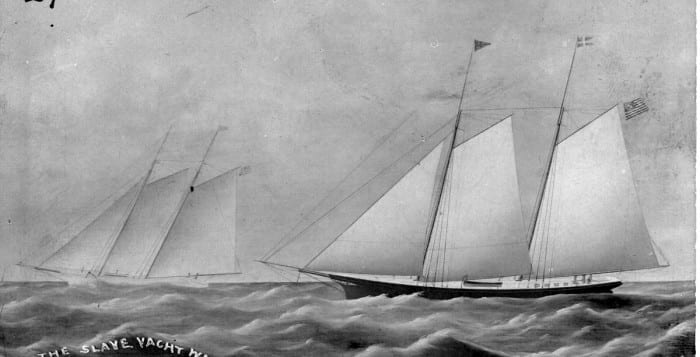by Beverly C. Tyler
Joseph Rowland’s home and shipyard is in East Setauket at the intersection of Shore Road and Bayview Avenue.
Rowland built the schooner-yacht Wanderer in 1857 for Colonel John D. Johnson who was a member of the New York Yacht Club, a wealthy sugar planter from New Orleans and had a home in the Islips. The Wanderer was designed by Captain Thomas B. Hawkins, who supervised construction.
The sails for the Wanderer were made in Port Jefferson in the Wilson Sail Loft. Wilson also made the first suit of sails for the schooner-yacht America, which captured the cup that still bears the name of that first winner.
That summer of 1857, the Wanderer sailed Long Island Sound with Captain Hawkins as its sailing master.
The ship’s owner, Johnson, sailed it with the New York Yacht Club Squadron. It was said to have been the fastest schooner ever built, too big and too fast so the yacht club wouldn’t let it compete.
That fall, Wanderer voyaged to Havana, via Charleston and Savannah, and it was very widely acclaimed.
However, Johnson sold the Wanderer in 1858 to William C. Corey and soon after it reappeared in Port Jefferson. It was fitted out for the slave trade, probably at the yard of J.J. Harris. Numerous large water tanks were installed. All the people looked the other way, except S.S. Norton, surveyor of the port. He became suspicious and notified federal officials in New York. The revenue cutter Harriet Lane intercepted the Wanderer off Old Field Point and took it in tow to New York over Corey’s loud protests.
Corey glibly talked himself free and the Wanderer was allowed to leave for Charleston, where the real owner Charles Augustus Lafayette Lamar surfaced. Actually he probably crawled out from under a rock. Lamar, staying in the background because of his previous connection with slavers, obtained customs clearance for it.
They completed fitting out for the slave trade and sailed for Africa. Its captain was John E. Farnum, a mean looking cuss.
Slavers were rigged to outrun the slave squadrons of Great Britain and America, both of which were trying to stop the now illegal slave trade. Wanderer took aboard some 600 “negroes” and sailed for America. The slaves were laid down side-by-side alternating head and feet and chained, wrist to ankle. They were kept lying there for days and there was no sanitation. Even worse, if a ship was overtaken by one of the slave squadrons, it was not uncommon to bend an anchor to the last man on the chain and let it go overboard, taking the whole cargo of slaves and destroying the evidence.
On the evening of Nov. 28, 1858, the ship landed 465 Africans on Jekyll Island, Georgia. The rest died during the voyage and were unceremoniously tossed over the side. The ship was seized by federal authorities; however, the Africans, now on Georgia soil, a slave state, were sold at auction.
There was outrage in the U.S. Congress; but little, if anything, was done, less than two years before the start of the Civil War. Wanderer was sold at auction and Lamar bought it. In the spring of 1861 it was seized by the federal government and used as a gunboat in the Civil War. It was credited with capturing four prizes. After the war, the U.S. Navy sold it to private owners who ran it aground on Cape Maisi, east out of Cuba, on Jan. 21, 1871, and she was a total loss. The mess kettle that was used to feed the slaves on Jekyll Island still existed in the 1970s but has since disappeared.
There was even a sign beside it that explained the history of the kettle and said that the Wanderer was built at East Setauket. In 2008, the Jekyll Island History Museum opened an exhibit on The Last Slaver.
A walking tour of the maritime and wooden shipbuilding area along Shore Road in East Setauket will be conducted this Saturday, June 13, beginning at 2 p.m. Meet at the Brookhaven Town Dock for a tour of the homes and shipyards that built ships that sailed around the world. The tour includes the home of the Wanderer shipbuilder and his story.
Beverly Tyler is the Three Village Historical Society historian.





